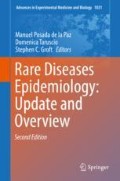Abstract
This chapter discusses the meaning of evidence-based medicine and where it relates to randomised controlled trials, but also where it does not. The need for good quality evidence is stressed through a discussion of high failure rates in drug development and arguments against access to unlicensed (and largely untested) treatments are set out (despite the good intentions of those who advocate such access to treatments).
Good quality, reliable evidence does not always have to come from clinical trials. Other forms of evidence are discussed. Meta-analyses of individual trials may help to resolve the problem that, in rare diseases, it may be very difficult or impossible to do adequately powered clinical trials – but that does not imply those trials have no value at all.
The importance of patients’ choices is stressed but the difficulties of making choices and the general poor understanding of risk can make patients and caregivers, as well as healthcare professionals, very vulnerable to making poor decisions. All stakeholders need to be adequately guided through the evidence to make proper informed decisions.
References
Booth B, Glassman R, Ma P (2003) Oncology’s trials. Nature Rev. Drug Discov 2:609–610
Chalmers TC (1968) When should randomisation begin? Lancet 1(7547):858
Chalmers TC (1975) Randomization of the first patient. Med Clin North Am 59:1035–1038
Chalmers TC (1977) Randomize the first patient! N Engl J Med 296:107
Committee for Medicinal Products for Human Use (CHMP) (2006) Guideline on clinical trials in small populations. European Medicines Agency, London
Day S (2009) Bayesian statistics. DIA global. Forum 1(6):34–35
DiMasi JA (2001) Risks in new drug development: approval success rates for investigational drugs. Clin Pharm Therap 69:297–307
GovTrack.US (2005) United States Senate Bill S.1956 – 109th Congress. To amend the Federal Food, drug and Cosmetic Act to create a new three-tiered approval system for drugs, biological products, and devices that is responsive to the needs of seriously ill patients, and for other purposes. http://www.govtrack.us/congress/bill.xpd?bill=s109-1956. Cited 31st Dec 2009
GRADE Working Group (2004) Grading quality of evidence and strength of association. Brit Med J 328:1490–1494
Green SB, Byar DP (1984) Using observational data from registries to compare treatments: the fallacy of omnimetrics. Stat Med 3:361–370
Hill AB (1951) The clinical trial. Brit Med Bull 7:278–282
Hill AB (1965) The environment and disease: association or causation? Proc Roy Soc Med 58:295–300
Institute of Medicine (2001) Small clinical trials: issues and challenges. National Academic Press, Washington, DC
International Conference on Harmonisation of Technical Requirements for Registration of Pharmaceuticals for Human Use (2000) ICH Harmonised Tripartite Guideline Choice of Control Group and Related Issues in Clinical Trials E10. International Conference on Harmonisation. http://www.ich.org/fileadmin/Public_Web_Site/ICH_Products/Guidelines/Efficacy/E10/Step4/E10_Guideline.pdf. Accessed 17 Oct 2016
Kola I, Landis J (2004) Can the pharmaceutical industry reduce attrition rates? Nature Rev Drug Discov 3:711–715
Malenka DJ, Baron JA, Johansen S, Wahrenberger JW, Ross JM (1993) The framing effect of relative and absolute risk. J Gen Int Med 8:543–548
Mangset M, Berge E, Førde R, Nessa J, Wyller TB (2009) “Two per cent isn’t a lot, but when it comes to death it seems quite a lot anyway”: patients’ perception of risk and willingness to accept risks associated with thrombolytic drug treatment for acute stroke. J Med Ethics 35:42–46
Matthews JNS (1995) Small clinical trials: are they all bad? Stat Med 14:115–126
Moyé LA (2008) Bayesians in clinical trials: asleep at the switch. Stat Med 27:469–482
Mussen F, Salek S, Walker S (2009) Benefit-risk appraisal of medicines. A systematic approach to decision-making. Wiley-Blackwell, Chichester
Okie S (2006) Access before approval – a right to take experimental drugs? N Engl J Med 355:437–440
Pearson H (2006) The bitterest pill. Nature 444:532–533
Phillips CV (2001) The economics of ‘more research is needed’. Int J Epidem 30:771–776
Piantadosi S (1990) Editorial. Hazards of small clinical trials. J Clin Oncol 8:1–3
Po LW (1998) Dictionary of evidence based medicine. Radcliffe Medical Press, Oxford
Reidenberg MM (1987) Should unevaluated therapies be available for sale? Clin Pharmacol Ther 42:599–600
Sackett DL, Rosenberg WMC, Gray JAM, Haynes RB, Richardson WS (1996) Editorial. Evidence based medicine: what it is and what it is not. Brit Med J 312:71–72
Saver JL (1995) Coping with an embarrassment of riches. Stroke 26:1289–1292
Schünemann HJ, Oxman AD, Vist GE, Higgins JPT, Deeks JJ, Glasziou GG (2008) Interpreting results and drawing conclusions. In: Higgins JPT, Green S (eds) Cochrane handbook for systematic reviews of interventions. Wiley, Chichester
Society for Clinical Trials Board of Directors (2006) The Society for Clinical Trials opposes US legislation to permit marketing of unproven medical therapies for seriously ill patients. Clin Trials 3:154–157
Spodick DH (1983) Randomize the first patient: Scientific, ethical, and behavioral bases. Am J Cardiol 51:916–917
Sutton AJ, Abrams KR, Jones DR, Sheldon TA, Song F (2000) Methods for meta-analysis in medical research. Wiley, Chichester
Tan S-B, Dear KBG, Bruzzi P, Machin D (2003) Strategy for randomised clinical trials in rare cancers. Brit Med J 327:47–49
United States Department of Health and Human Services (2009) Code of federal regulations 21 CFR 314.126. Adequate and well controlled studies. http://www.accessdata.fda.gov/scripts/cdrh/cfdocs/cfcfr/CFRSearch.cfm. Accessed 17 Oct 2016
Whitehead A (2002) Meta-analysis of controlled clinical trials. Wiley, Chichester
World Medical Association (2013) World medical association declaration of Helsinki – ethical principles for medical research involving human subjects. JAMA 310:2191–2194
Author information
Authors and Affiliations
Corresponding author
Editor information
Editors and Affiliations
Rights and permissions
Copyright information
© 2017 Springer International Publishing AG
About this chapter
Cite this chapter
Day, S. (2017). Evidence-Based Medicine and Rare Diseases. In: Posada de la Paz, M., Taruscio, D., Groft, S. (eds) Rare Diseases Epidemiology: Update and Overview. Advances in Experimental Medicine and Biology, vol 1031. Springer, Cham. https://doi.org/10.1007/978-3-319-67144-4_12
Download citation
DOI: https://doi.org/10.1007/978-3-319-67144-4_12
Published:
Publisher Name: Springer, Cham
Print ISBN: 978-3-319-67142-0
Online ISBN: 978-3-319-67144-4
eBook Packages: Biomedical and Life SciencesBiomedical and Life Sciences (R0)

